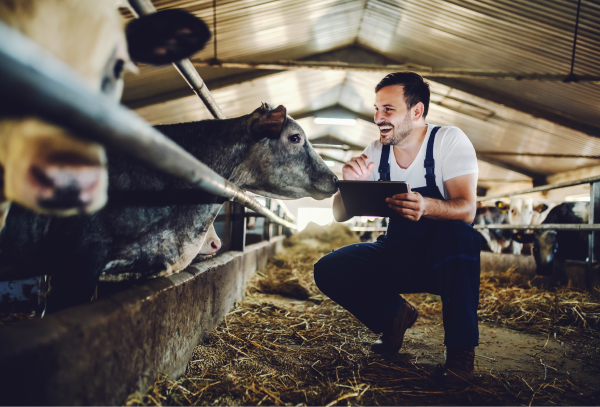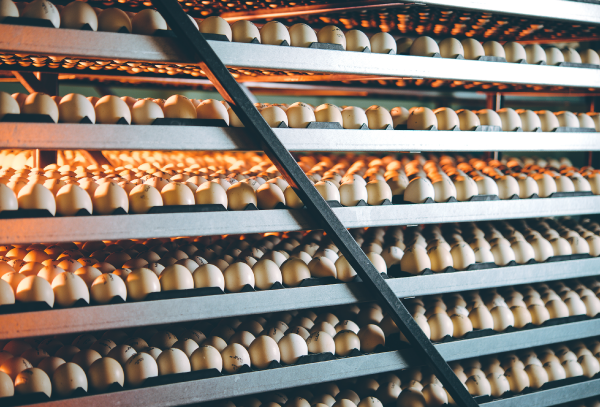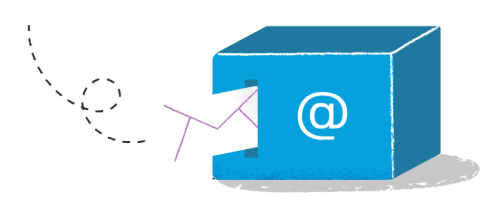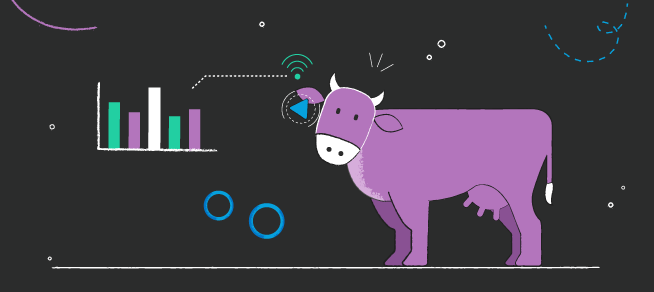
AI-Based Smart Farming. The Rise of Machine Learning in Livestock Farming
Inside this article:
The digital age is upon us, and a new era of smart farming comes as follows. Machine learning and artificial intelligence are used to revolutionize how livestock is managed and monitored. From poultry and dairy cows to pigs, AI-based systems improve livestock production and management. Machine learning algorithms are an integral part of precision livestock farming. Farmers use it to streamline the monitoring of animal behavior and welfare, predict disease outbreaks, and optimize feeding schedules. This article presents some of the AI use cases in smart farming. Check how it is helping to improve livestock production.
TL;DR
• Precision Livestock Farming (PLF) powered by Artificial Intelligence (AI) technology is revolutionizing animal farming practices.
• Smart farming processes help gather relevant data for AI to identify and predict animal health issues and provide insights into their history, nutrition, and weight.
• The use of AI in animal farming can improve animal welfare, increase productivity, and provide valuable insights to producers.
• By using AI producents can monitor the living conditions of the animals and detect any anomalies that could affect them in a negative way also reducing the environmental impact, stimulate production and maintain the highest quality.
• Nexocode data engineers can help you implement the best AI systems to improve your animal farming operations.
Advances in Animal Farming and Agriculture
The progress we have seen in agriculture and animal farming in the last century is astonishing. Full automation of crop collection or environmental conditions monitoring would seem unreachable a few decades ago, and today, it has become a standard. With the help of technology and advanced machinery, we have found ways to maximize productivity in these sectors - not only in pursuit of profit but also in order to cope with the world’s growing population needs.
However, there are two sides to the coin. The progress came at a cost. With the development of large-scale farming, the conditions have worsened in some aspects. As the demand for animal products has been growing, farming facilities have been expanding in size while reducing space use in order to maintain cost efficiency. That does not have a great impact on animal health(to say the least).
Rising demand also creates challenges in terms of quality assurance. In the conditions that mass production dictates, it is much harder to keep the industrial farming environment entirely safe. The environmental impact of the industry is another aspect to tackle. The pollution it causes, soil exhaustion, and, even more importantly, its carbon footprint - all these problems have been escalating in recent decades despite increasingly strict regulations.
Artificial intelligence allows us finally target these issues without compromising productivity. Actually, rather the opposite – if used thoughtfully, AI stimulates it while fuelling sustainability and improving animal welfare. Now that the ethical aspects of the practices in this sector are gaining even more importance among customers, artificial intelligence can help farmers adjust to their evolving expectations.
Precision Livestock Farming Technology
In a nutshell, precision livestock farming (PLF) describes a set of tools that allow farmers to control and improve their animals’ health and welfare, the conditions in which they live, and their reproduction. In this article, we will take a look at all these areas through the lens of artificial intelligence technology. It is becoming increasingly common to engage AI in these processes as it allows the farmers to draw better conclusions from their data and combine all the elements (cameras, microphones, scanners, sensors) into a coherent system that supports decision-making, accurate predictions, and anomaly detection.
Smart Farming
While precision livestock farming refers to tools, smart farming expresses the approach to processing information. Its objective is to use the available data across the farming processes in order to optimize them. What’s worth noting, the smart approach does not necessarily involve the use of advanced machinery and full automation.
The data is the clou here - farmers working in a smart way try to gather as much relevant information as possible and make sense of it. For it to be possible, they integrate artificial intelligence-fuelled software into their processes, often paired with IoT devices that collect information regarding the conditions of the farming facilities, product quality, etc. Smart farming and precision livestock farming approaches complement each other, helping livestock producers improve animal health and outcomes.
Applications of Big Data and AI in Livestock Farming - Use Cases
Artificial intelligence can serve to streamline livestock farming in various ways and forms. Many of them involve computer vision and advanced predictive analytics. Let’s take a look at some of the most common use cases to understand the spectrum of AI’s potential in this sector.
Animal Identification
Identification of livestock is required by the regulatory organs but also guarantees safety and helps the farmers improve the quality of products and their animals’ welfare. In the past, the farmers would know their animals - their health history, age, reproduction, growth, birth date, nutrition habits, etc.
With the expansion of farming, we can maintain this good practice with a little help from technology. In many livestock farming units, each animal’s path is registered and monitored from the day of birth. That requires an identification system that will keep the track of different variables, expanding the information base about each individual animal.
Harness the full potential of AI for your business
Sign up for newsletterArtificial intelligence facilitates processing this data and drawing insights out of it. By engaging computer vision, the farmers can entirely automatize the identification of livestock. It is enough to scan the identification number of the code to access all the relevant information regarding a particular animal’s state and history. With AI, even the smaller animals, like poultry, can be identified individually, instead of per flock. That lowers the epidemiological risk and facilitates improving welfare in these particularly challenging conditions.
Automated Weighing Systems
Weighing is crucial in terms of quality control. Animals can be weighed either individually or in groups (that, again, refers more to poultry and other small animals). What’s important, weighing is often a source of stress for the animals that try to avoid entering the scale. That affects both their welfare and the effectiveness of the process.
That’s why it is crucial to make the whole process as smooth and short as possible. Automation helps with that. Sensitive sensors can precisely detect weight in a split second and automatically register the results in the database, removing the necessity to scan them manually. What’s more, incorrect weight can indicate a health issue or inappropriate nutrition patterns.
An artificial intelligence system can process this data and draw insights on its basis, facilitating the improvement of farming conditions. By identifying a particular animal, the system is capable of finding correlations between its weight and its history. That streamlines quality assurance processes.
Animal Welfare Monitoring and Identifying Diseased Individual Animals
The large scale industrial farming, regardless of being subject to tight quality control norms, creates favorable conditions for epidemiological danger to appear. That makes thorough monitoring so crucial and necessary. Artificial intelligence has the power to significantly improve animal welfare while reducing epidemiological risks at the same time. Here’s a detailed look at how it’s possible.
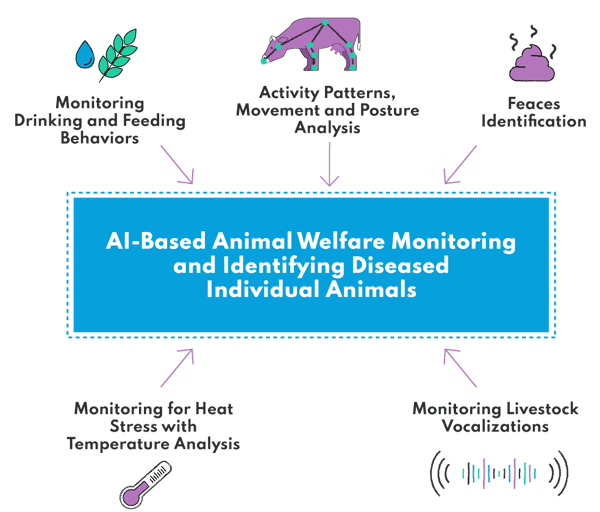
Monitoring Drinking and Feeding Behaviors
The IoT devices powered with computer vision can register the patterns in drinking and feeding habits of the livestock, providing the farmers with valuable insights. The sensors support that process, registering the levels and tempo of consumption throughout the day and night to monitor animal behaviors and detect anomalies.
With the data processed by the AI system, the farmers are able to identify the animals with unusual nutrition habits, which can be a sign of health or behavioral issues. At the same time, they can use the acquired data to find correlations between the particular food and the health and weight of the livestock. This way, it becomes an important quality control tool.
Activity Patterns, Movement and Posture Analysis
The same tools listed above can serve to analyze other patterns essential to effective quality control. Such variables as activity throughout the day and night, movement, and posture can be significant indicators of the animal’s health. Machine learning algorithms paired with computer vision can identify them, classify them and link them to the symptoms of the particular problem, automatically issuing an alert.
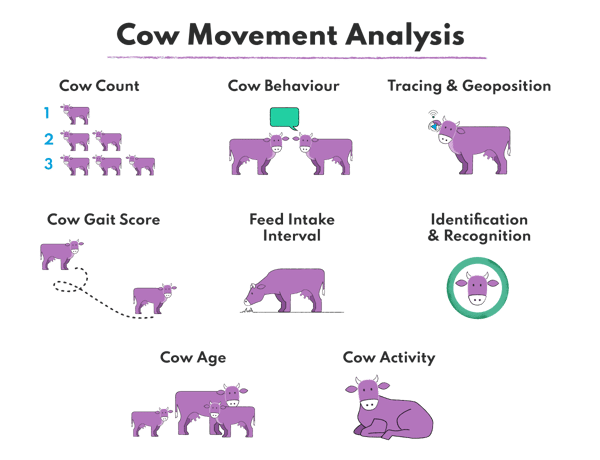
Feces Identification
Feces can be a source of insightful information regarding animal welfare. With computer vision, the farmers can automatize their inspection instead of doing it manually in order to detect anomalies. In the case the animal is infected with bacteria, the feces will also contain it. The artificial intelligence system can quickly identify the potential danger of contamination based on the analyzed sample and provide insights to the farmer. Such a mechanism is a significant component of epidemic prevention practices.
Monitoring for Heat Stress with Temperature Analysis
Another way artificial intelligence can improve animal welfare is by monitoring heat stress. Due to the high concentration of livestock in a relatively limited space, the farm animals can be exposed to high temperatures, which often has a devastating effect on both their physical and mental health - particularly long term.
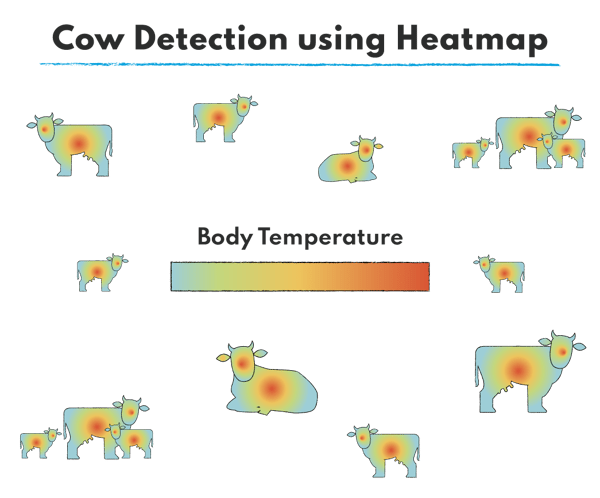
The sensors integrated with the artificial intelligence-based system can collect the temperature data, extracting insights regarding its rises and drops and linking it to particular events or behaviors. The machine learning model identifies patterns that elevate the risk of heat stress and issues an alert in real-time when the temperature reaches the level identified as risky. Also, the farmers can use the acquired data to introduce improvements in this area.
Monitoring Livestock Vocalizations
Just as feces, livestock vocalizations can be a valuable source of information helping the farmers assess animal welfare. A machine learning algorithm trained with audio data extracted from the recordings can identify the anomalies in the animal vocalizations and classify them based on the previously detected pattern.
By combining this source of information with the previously mentioned, the farmer is able to get a complete overview of his livestock state. Live recordings can also serve as a way to control the behaviors among the farm animals and the dynamics between them. If any pathological behaviors occur, the system provides the farmer with the capability to prevent their spreading and act right away.
Monitoring and Altering Shed and Aquaculture Conditions
Aside from controlling the welfare of livestock, artificial intelligence is also helpful when it comes to controlling conditions. It is crucial not only for the quality of their products but also the general safety and compliance with regulatory norms. Minor changes in conditions (humidity, temperature, space, brightness, etc.) can have major implications on the productivity of the breeding and other essential processes. Here we describe the main areas in this respect, that artificial intelligence can streamline.
Designing Feeding Patterns
We have already mentioned that feeding and drinking behaviors can serve as indicators of animal welfare. The data collected for monitoring purposes can also serve the purpose of finding the most optimal feeding patterns to increase productivity and maximize product quality while keeping expenses low.
Fed with an extensive dataset, the algorithm (preferably deep learning one) is capable of identifying the correlation between the desirable behaviors/quality of the product and particular feeding patterns. Advanced analytics allows the farmer to test various configurations and find the optimal ones. That, of course, affects the overall productivity of the farming process in a positive way.
Pasture Evaluation
With computer vision, livestock farming companies can control the pasture conditions automatically in order to verify whether it provides the animals with the appropriate feeding conditions. The AI recognition system powered by a trained algorithm can rate the pasture, issuing recommendations on this basis. It may, for instance, register empty spots and pasture that does not fulfill the quality norms because of fungal infections, dryness, or other relevant variables.
Based on the registered image, the farmers can also estimate the quantities of pasture available for the animals and analyze whether these numbers go in line with their recommended daily intake per their body weight.
Optimizing Hatcheries
Hatcheries enable farmers to create optimal conditions for the embryos in the eggs to develop. In industrial production, it is not possible to do it in the traditional way that involves animals. Thus, the farmers face the challenge of imitating the environmental parameters the eggs receive through natural hatching. It requires precision and constant monitoring, as any change in temperature and humidity may affect the incubation process.
The artificial intelligence system connected to sensors and incubators can extract and evaluate the relevant data to identify any condition changes that could interrupt the development of the embryos. Based on these insights, they can introduce improvements to maintain an incubation process. At the same time, it monitors the impact particular conditions has on fertility, learning on this basis and constantly improving its recommendations.
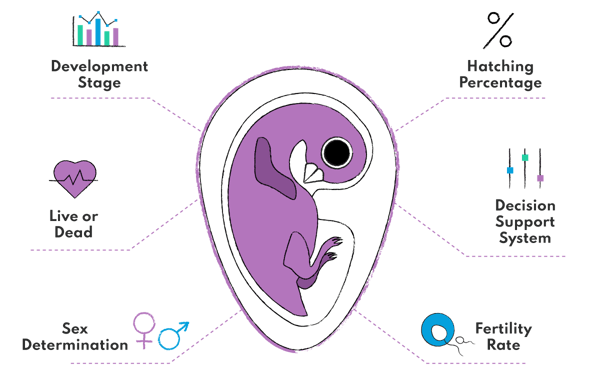
Identifying Live Embryos in Eggs
Early identification of non-hatchable and infertile eggs protects the farmers from unnecessary costs, optimizing the hatchery space use and improving its overall productivity. To be able to do that, they can combine near-infrared hyperspectral imaging techniques with machine learning. ML algorithms trained with the datasets containing images of fertile and infertile eggs classify them so that farmers can remove the latter from the hatchery as soon as possible.
Monitoring Embryos Development
Computer vision can serve not only for detecting the fertile eggs but also for their further monitoring. Poultry producers are starting to introduce incubators equipped with a time-lapse imaging system and appropriate software that can process the visual data and draw conclusions from it. The machine learning model, trained with images that document the correct embryo development, is capable of detecting anomalies at each stage and alerting the hatchery managers so that they can avoid waste and maintain their productivity as high as possible. Moreover, if such a system is paired with sensors, it provides them with insights into the conditions’ impact on embryo development.
Sex Determination
Another application of artificial intelligence that we will call out here could put an end to the controversial procedure of killing male chicks on farms. As Bayern states in its study, over 100 million male chicks are killed in German breeding farms every year since they are useless from the profit perspective. By determining the sex in the first days of incubation, the livestock producers can switch to a more ethical, but also more productive model. It is possible with a combination of magnetic resonance imaging (MRI) combined with artificial intelligence models that evaluate and classify the images. You can read a little more about this procedure here.
Detecting Breeding Times and Reproduction Monitoring
The livestock producers can also engage the predictive analytics to optimize their breeding programs. The artificial intelligence system can monitor the cycle of the female animals and their heat times, suggesting the preferable insemination time. What’s important, various environmental variables also have an impact on the probability of fertilization. The system recommends the best breeding times based on the combination of all these data.
Benefits of Applying Machine Learning in Precision Livestock Farming Technologies
As you can see, machine learning technology provides livestock farmers with the capability to significantly improve the animals’ welfare. It is essential for the quality of their products, but also from the ethical and regulatory perspective. With smart devices and advanced software, it is easier than ever to monitor the living conditions of the animals and detect any anomalies that could affect them in a negative way. At the same time, the system records the behavioral patterns among animals and links them to particular variables and their combinations. That allows the farmers to constantly improve their conditions to stimulate production and maintain the highest quality.
Using artificial intelligence technology, livestock producers are capable of reducing the environmental impact of their activity and cutting controversial practices that are both ethically debatable and unsustainable. Particularly when it comes to reducing the carbon footprint, artificial intelligence is unbeatable support, allowing farmers to minimize the use of resources and improve the sustainability of their feeding patterns and overall farm productivity.
The Future of Animal Farming
As the world becomes increasingly more digitized, it’s important that the agricultural industry follows suit. With the use of new technologies and artificial intelligence, we’re able to optimize livestock farming and improve the welfare of animals. I think it’s crucial that we focus on animal welfare as it is a priority for many consumers. For the agricultural industry to remain sustainable and profitable, we must consider the well-being of animals.
Artificial intelligence provides them with tools that facilitate these changes without additional expenses and hiring more workforce. At the same time, it may solve the pressing problem of space by suggesting more optimal management of the farms and hatcheries.
The number of vegans worldwide has grown tremendously in the last decade, but on a global scale, they still constitute only 1% of all consumers. The consumption of animal products will likely continue high in the following decades, but the industry will not likely continue in the shape that we are used to. Aside from reducing its environmental impact, the farmers’ focus will likely shift to improving the conditions in which the animals are kept - also due to the consumers’ pressure.
My very personal opinion on that matter is to think that veganism should be a priority for modern societies. The benefits of a vegan lifestyle are vast and far-reaching. We’re able to reduce our carbon footprint, save water, and improve human health when we remove meat and dairy from our diets. I believe that if everyone made small changes in their lifestyle, we could make a big difference in the world.
Are you interested in exploring AI’s potential for your business? We would love to assist you with that! Drop us a line, and let’s see what we can do for you.
